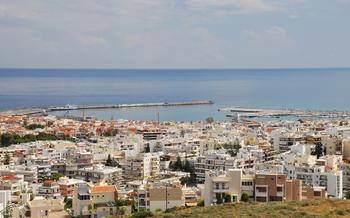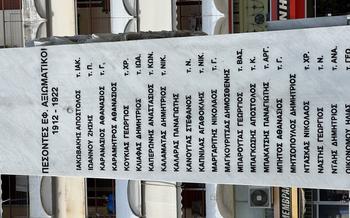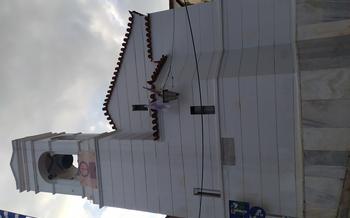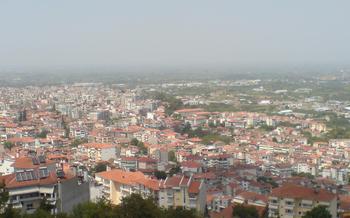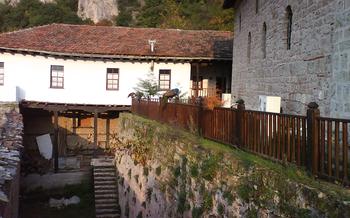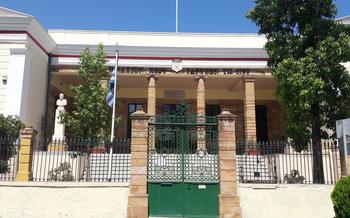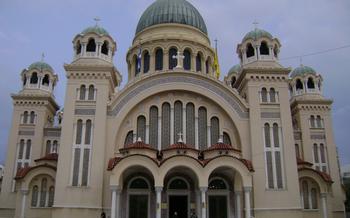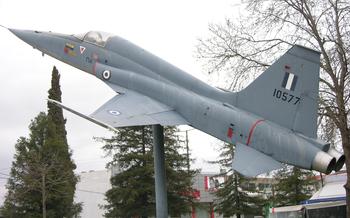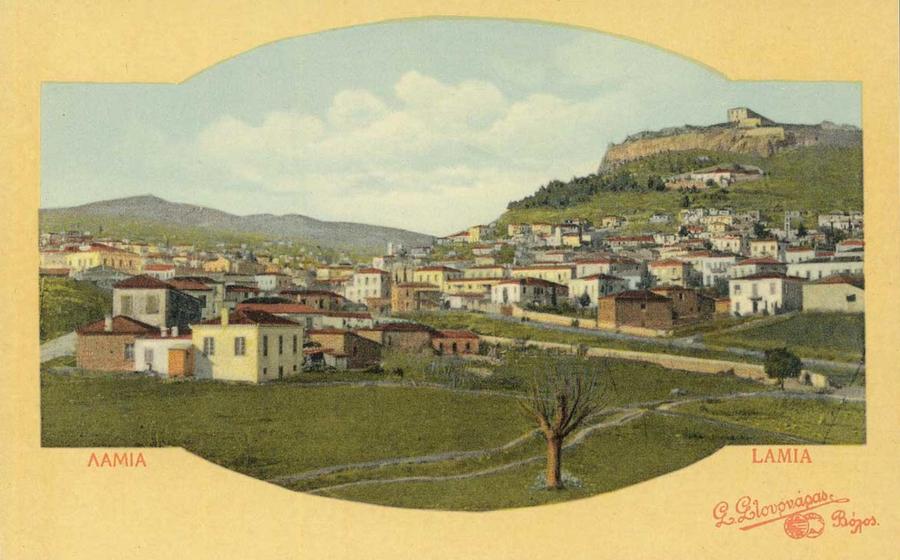
Laographic Museum Lamia
- Location and Accessibility
- Museum Highlights
- Traditional Greek Costumes
- Handicrafts and Woven Textiles
- Agricultural Implements
- Religious Artifacts
- Folkloric Music Instruments
- Educational Programs
- Temporary Exhibitions
- Guided Tours
- Museum Shop
- Accessibility and Facilities
- Insider's Tip:
Location and Accessibility
The Laographic Museum Lamia is conveniently located in the heart of the city, at 16 Karolou Street. Visitors can easily reach the museum on foot while exploring the vibrant city center. Alternatively, multiple public transportation options, including local buses and taxis, stop nearby, ensuring seamless accessibility. The museum is also committed to providing an inclusive experience for all visitors. It features accessible entrances, ramps, and elevators, making it fully wheelchair-accessible. Visitors with disabilities are encouraged to contact the museum staff in advance to ensure a smooth and enjoyable visit.
Museum Highlights
Among the must-see exhibits within the Laographic Museum Lamia is the impressive collection of traditional Greek costumes. These intricate garments showcase the diverse cultural heritage of the region, with each costume representing a different area or village. Visitors can marvel at the vibrant colors, intricate embroidery, and unique designs that adorn these traditional attires.
Another highlight of the museum is the display of agricultural implements. These tools provide a glimpse into the traditional farming practices of the region and their significance in the local economy. From simple hand tools to more complex machinery, these exhibits offer insights into the ingenuity and resourcefulness of Greek farmers throughout history.
Interactive and multimedia displays enhance the visitor experience, bringing history to life. Touchscreens and audio guides provide detailed information about the exhibits, allowing visitors to delve deeper into the cultural and historical context of the region. These interactive elements make learning about Greek traditions both engaging and accessible for visitors of all ages.
Traditional Greek Costumes
The Laographic Museum Lamia houses a remarkable collection of traditional Greek costumes from various regions of the country. These intricate and colorful garments offer a glimpse into the cultural and historical diversity of Greece. Each costume tells a story of its own, reflecting the unique traditions and customs of its region.
From the elaborate wedding dresses of the Peloponnese to the colorful skirts and blouses of Crete, the museum's collection showcases the artistry and craftsmanship of Greek costume makers. Visitors can admire the intricate embroidery, delicate lacework, and vibrant colors that adorn these garments.
The museum's collection also includes a variety of accessories, such as headdresses, jewelry, and footwear, which complete the traditional Greek attire. These accessories often hold symbolic meanings and add to the overall charm of the costumes.
By preserving and showcasing these traditional costumes, the Laographic Museum Lamia plays a vital role in safeguarding Greece's rich cultural heritage. These garments serve as a reminder of the country's diverse history and the enduring traditions that continue to shape its identity.
Handicrafts and Woven Textiles
The Laographic Museum Lamia houses a diverse collection of intricate handicrafts and woven textiles, showcasing the traditional skills and artistry of the region. These crafts, passed down through generations, hold immense cultural significance and reflect the creativity and ingenuity of the Greek people.
Among the highlights of the collection is a stunning array of woven textiles, including hand-woven rugs, tapestries, and embroideries. Each piece is a testament to the meticulous craftsmanship and artistic flair of the weavers. The vibrant colors, intricate patterns, and symbolic motifs tell stories of the region's history, traditions, and beliefs.
Visitors can also admire a variety of handcrafted items, such as pottery, metalwork, and woodworking. These objects, ranging from decorative plates and vases to ornate jewelry and intricate carvings, showcase the diverse skills and techniques employed by local artisans. The museum's collection provides a glimpse into the rich heritage of Greek craftsmanship and the enduring legacy of traditional arts.
The Laographic Museum Lamia serves as a vital repository for these precious handicrafts and woven textiles, ensuring their preservation and appreciation for generations to come.
Agricultural Implements
The Laographic Museum Lamia also houses a remarkable collection of traditional agricultural implements, providing visitors with a glimpse into the rich farming heritage of the region. These tools, crafted by skilled artisans using local materials, showcase the ingenuity and adaptability of Greek farmers. From simple hand tools to complex machinery, each implement holds a story of perseverance, innovation, and connection to the land.
A highlight of the collection is the traditional plow, an essential tool for breaking and turning the soil. Visitors can marvel at its sturdy construction and intricate design, crafted to withstand the challenges of the Greek terrain. Other notable exhibits include threshing machines, used to separate grain from chaff, and wine presses, which played a crucial role in the production of one of Greece's most famous products—wine.
These agricultural implements not only served a practical purpose but also held cultural significance. They were often passed down from generation to generation, embodying the continuity and resilience of farming traditions. By preserving and showcasing these tools, the Laographic Museum Lamia pays homage to the hard work and dedication of Greek farmers throughout history.
Religious Artifacts
Among the diverse exhibits at the Laographic Museum Lamia, the collection of religious artifacts holds a special place. These artifacts offer a glimpse into the deep-rooted faith and traditions of the Greek Orthodox community. Icons, crosses, and other sacred objects are meticulously displayed, each carrying its own story of devotion and reverence.
Intricately painted icons adorn the walls of the museum, their vibrant colors and gold leaf evoking a sense of awe and spirituality. These icons depict various saints, religious scenes, and moments from the Bible, serving as a testament to the artistic prowess of Greek iconographers.
Elaborately crafted crosses, some adorned with intricate carvings or gemstones, symbolize the central role of Christianity in Greek culture. They represent both the sacrifices made by Jesus Christ and the unwavering faith of the Greek people.
Other religious artifacts, such as censers, prayer books, and vestments, provide insights into the rituals and customs of the Greek Orthodox Church. These objects, often adorned with intricate embroidery or metalwork, showcase the artistry and craftsmanship that goes into the creation of sacred items.
Exploring the collection of religious artifacts at the Laographic Museum Lamia is a journey into the heart of Greek Orthodox tradition. These artifacts serve as a reminder of the deep spiritual connection that permeates Greek culture and the enduring legacy of faith that continues to shape the lives of the Greek people.
Folkloric Music Instruments
The Laographic Museum Lamia houses a diverse collection of traditional Greek musical instruments, offering visitors a glimpse into the rich musical heritage of the region. These instruments, each with its unique origins and construction, showcase the creativity and artistry of Greek craftsmen and musicians.
Among the highlights of the collection are the lyra, a three-stringed instrument similar to a fiddle, known for its haunting melodies and association with traditional Greek folk music. Visitors can also admire the santouri, a trapezoidal dulcimer with numerous strings, which produces a delicate and ethereal sound.
The museum also displays a variety of percussion instruments, including the daouli, a large double-headed drum used in traditional dances, and the tambourine, a handheld frame drum with jingles, which adds a rhythmic beat to folk music performances.
These instruments, along with many others, played a crucial role in Greek culture, accompanying celebrations, festivals, and social gatherings. They served as a means of expressing emotions, preserving cultural traditions, and connecting people through music.
The museum's collection of folkloric music instruments not only showcases the diversity of Greek musical traditions but also provides visitors with an opportunity to appreciate the craftsmanship and artistry behind these cultural treasures.
Educational Programs
The Laographic Museum Lamia is committed to promoting cultural education and preserving traditional knowledge. It regularly organizes educational programs and workshops to engage visitors of all ages, particularly students and families. These programs aim to provide a deeper understanding of Greek culture, history, and heritage through hands-on activities, interactive presentations, and storytelling sessions.
The museum's educational programs cover a wide range of topics, including traditional crafts, folk music, dance, and storytelling. Participants have the opportunity to learn about the techniques and skills used by artisans to create intricate woven textiles, pottery, and woodwork. They can also explore the origins and playing techniques of traditional Greek musical instruments and learn about the history and significance of traditional Greek dances.
To participate in these educational programs, visitors can contact the museum directly or check its website for upcoming events and schedules. The museum's experienced educators and workshop leaders are passionate about sharing their knowledge and ensuring that visitors have a memorable and enriching experience.
Temporary Exhibitions
The Laographic Museum Lamia also hosts a variety of temporary exhibitions and special events throughout the year. These exhibitions showcase specific themes or aspects of Greek culture, history, and folklore. They may feature artifacts from the museum's collection, as well as items on loan from other institutions or private collectors.
Past exhibitions have explored topics such as traditional Greek weaving techniques, the history of Greek Orthodox iconography, and the role of music in Greek folk traditions. Temporary exhibitions offer visitors an opportunity to delve deeper into specific areas of Greek culture and gain new perspectives on the region's rich heritage.
Information about current and upcoming exhibitions can be found on the museum's website or by contacting the museum directly. These exhibitions contribute to the museum's mission of preserving and promoting Greek culture by presenting diverse and engaging content to visitors.
Guided Tours
For a more immersive and educational experience, consider booking a guided tour of the Laographic Museum Lamia. Knowledgeable and passionate guides will lead you through the exhibits, providing in-depth explanations and historical context. They can answer your questions, share stories and anecdotes, and help you gain a deeper understanding of the cultural heritage showcased in the museum. Guided tours are available in various languages and can be arranged in advance by contacting the museum directly. Whether you're a history buff, a culture enthusiast, or simply curious about Greek traditions, a guided tour will elevate your visit to the Laographic Museum Lamia.
Museum Shop
The Laographic Museum Lamia also features a well-stocked museum shop where visitors can purchase a variety of souvenirs and mementos to commemorate their visit. The shop offers a diverse selection of items, including books on Greek culture, history, and folklore; postcards depicting scenes from Lamia and the surrounding region; and a variety of traditional handicrafts and woven textiles. These items not only serve as souvenirs but also support the museum's mission to preserve and promote Greek cultural heritage. Visitors can find unique and authentic gifts for themselves or loved ones, while simultaneously contributing to the museum's ongoing efforts to showcase the rich cultural traditions of Greece.
Accessibility and Facilities
The Laographic Museum Lamia is committed to providing an inclusive and accessible experience for all visitors. The museum is wheelchair accessible, featuring ramps and elevators to ensure that all floors and exhibits are easily accessible. Additionally, the museum offers a variety of amenities to enhance the visitor experience, including clean and well-maintained restrooms, a small cafeteria serving refreshments and snacks, and a cloakroom where visitors can store their belongings during their visit. These facilities contribute to a comfortable and enjoyable visit for all guests, allowing them to fully immerse themselves in the museum's rich collection and cultural heritage.
Insider's Tip:
To make the most of your visit to the Laographic Museum Lamia, consider planning your trip during the shoulder seasons (spring or fall) to avoid the summer crowds. This will allow you to explore the exhibits at your own pace and engage with the museum staff for a more personalized experience. After your visit, take a short walk to the picturesque Kyriaki Park, located just a few minutes away. This beautifully landscaped park offers scenic views of the city and is a great place to relax and reflect on the cultural treasures you've encountered at the museum.
